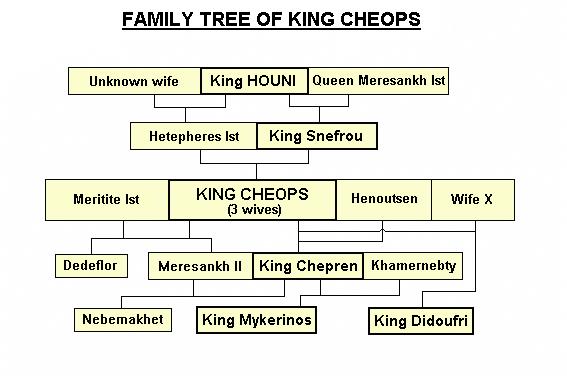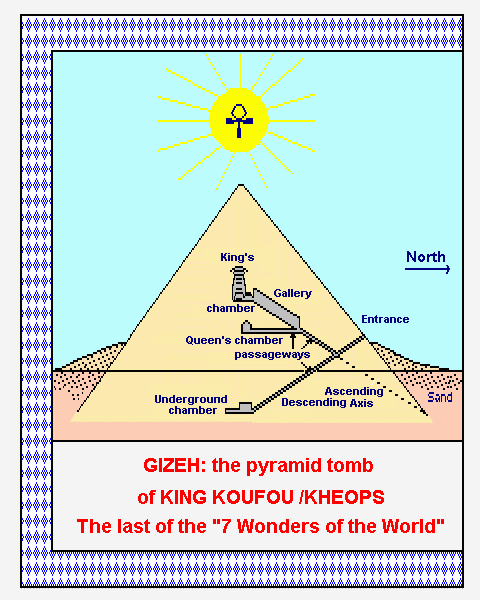
| Pharaohs of the IVth dynasty |
Names on the royal lists |
Dates
of |
||
Nebty name |
Greek name |
Papyrus of Turin | |
SNEFROU |
.... |
Snefou |
2694 to 2665BC |
KOUFHOU |
Cheops |
Khoufou |
2665 to 2626BC |
Djedef-Re |
Didoufri |
Djedef-Re |
2626 to 2618BC |
Khaef-Re |
CHEPHREN | Khaef-Re |
2618 to 2593BC |
Menkaou-Re |
Mykerinos |
Menkaou-Re |
2593 to 2569BC |
Shepseskaf |
.... |
Shepseskaf |
2569 to 2563BC |
This list is by no means comprehensive, and other names are often assigned to them on other lists (!)

The reign of King CHEOPS (around 2665 to 2626BC)
The Egyptians considered Cheops to be the 2nd most famous king after Ramses II. But apart from the great monument which bears his name, we have few documents telling of his exploits or his private life! We know that this king had a particular taste for stories and legends. The majority of historians agree that although he was very well-liked during his life, he was the object of hatred and criticism after his death!
According to the Greek Herodotus :

Herodotus seems to be unaware of the existence and the name of the builder of the famous channel parallel to the Nile that had to be built to allow boats to travel from the necropoles to the quarries in the south.When one knows that this complex was made of sandstone monoliths, some of which weigh more than a hundred tons, and covering a square base of 54 200 square meters, on a gradient which reached 148 M. high, one has some idea of the effort provided by the people, who were enlisted in turn, according to a calendar, to provide three months of obligatory work.
But at the side of king Cheops, we are aware of someone, whose name we do not know, an architect and designer of the project, (who could not be Cheops), though according to the fourth part of the Westcar papyrus, the king was very interested in the " secret rooms of the sanctuary of Thot."
It has been shown subsequently that the architect of this mysterious pyramid used some techniques still unexplained to this day : concerning the aspect of the building and the standardization of the measurements. The interior passageways have been interpreted by certain famous scolars to tell the history of humanity.
Even though these theories, exposed partly in the esoteric book of Georges Barbarin, (The secret of the Great Pyramid- Edict. Adyar), has somewhat surprised the layperson, one must confess that the internal measurements, the aspect and the geographical situation of this huge monument have an esoteric, mysterious, and surprising side, and still many secrets remain hidden among those stones!
Does this pyramid contain some revelations about civilizations extinct after the deluge? What is the secret knowledge which enabled the builders to put in place those enormous stones (without cement); contemporary architects are still amazed!
What is the link between the Book of the Dead and the plans for the Pyramid, whose stones still speak to us! The Book of the Dead names the biggest pyramid of the world as :
and in the opinion of the ancient Egyptians, "the house of the snake" would become a " repository of wisdom and the home of Light (!) " (Al Ahram).

Two great men of the period CHEOPS / SNEFROU :
Certainly Egyptian life was not based always on religion and peace! Egypt alternated between periods of pomp and splendor, and darker periods of civil war, anarchy, and the coming of invaders. (These dark periods are called the Intermediate Periods). They came in between two calmer periods, where often the people had different religious concepts. Despite this, the Egyptians kept at the bottom of their hearts this incredible spiritual wealth, this message that they had learned earlier, this personal knowledge of the divine, and especially the certainty that another life exists in order to reward our good actions. These attributes also amazed the Greeks and the Romans.
But why does one always more quickly forget the moments of happiness than those of adversity in times of trial?
o - o - o - o - o - o - o